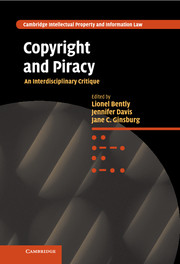Book contents
- Frontmatter
- Contents
- Notes on the contributors
- Editors' preface
- Table of cases
- Table of statutes
- Part I Introduction
- Part II History
- 2 Nineteenth-century Anglo–US copyright relations: the language of piracy versus the moral high ground
- 3 Language, practice, and history
- Part III Comparative Law
- Part IV Economics
- Part V Linguistics
- Part VI Computer software
- Part VII Information studies
- Part VIII Literature
- Part IX Art
- Part X Sociology/music
- Part XI Criminology
- Bibliography
- Index
3 - Language, practice, and history
from Part II - History
Published online by Cambridge University Press: 17 November 2010
- Frontmatter
- Contents
- Notes on the contributors
- Editors' preface
- Table of cases
- Table of statutes
- Part I Introduction
- Part II History
- 2 Nineteenth-century Anglo–US copyright relations: the language of piracy versus the moral high ground
- 3 Language, practice, and history
- Part III Comparative Law
- Part IV Economics
- Part V Linguistics
- Part VI Computer software
- Part VII Information studies
- Part VIII Literature
- Part IX Art
- Part X Sociology/music
- Part XI Criminology
- Bibliography
- Index
Summary
Catherine Seville's chapter performs at least three major services for the historian of copyright. The first is to treat the British and American sides in the bitter struggles over transatlantic reprinting symmetrically. One would have thought that this would be an elementary requirement for any self-respecting historian, but in fact sympathetic attention to the case for reprinting has been scarce, particularly for the very period on which Seville focuses: that between the first organized campaign for an international copyright measure and the eventual adoption of a protocol in the 1890s. The second is to demonstrate that this conflict did change its character over time. What it meant to argue against – or, more interestingly, for – transatlantic reprinting was significantly different in 1790 from what it would be in 1890. And Seville shows, third, that these changes took place at a semantic level. The language of piracy itself took on different connotations, becoming more overtly moral as the debate intensified. In each respect, her chapter tackles a major problem that dogs the historiography of intellectual property: its tendency to presume a normative tone, its legal essentialism, and its neglect of the fine grain of cultural history.
None of these three services should be regarded as taking precedence over the others. They are interdependent. Their underlying thread, it seems to me, is an insistence that the meanings of actions and statements can only be appreciated in terms of their embedding in situations of practice, which have their own chronologies.
- Type
- Chapter
- Information
- Copyright and PiracyAn Interdisciplinary Critique, pp. 44 - 52Publisher: Cambridge University PressPrint publication year: 2010



